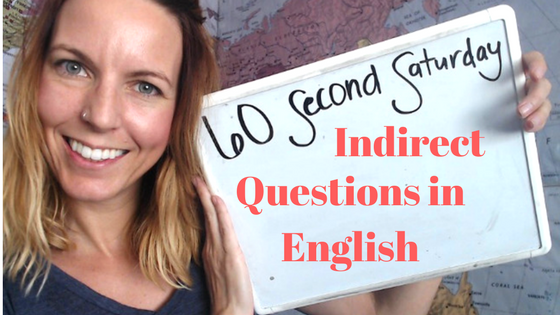
Using Indirect Questions in English
Is there a difference between sentences and questions that you need to know when changing direct speech into indirect/reported speech?
Although we’ve already reviewed necessary rules for indirect speech on this blog, including required time tense changes, I haven’t yet taught the specifics related to indirect questions. Because it’s “question month” for the rest of July, I want you to understand the most important rules for this important grammar point.
In this 60 Second Saturday lesson, you’ll review how to change questions from direct speech into reported speech, or indirect questions.
Indirect Questions in English
In reported speech for sentences, you’ve learned that you need a reporting verb (said, told, explained, etc…), sometimes need to change the time tense, and have the optional use of introducing the statement with “that“.
Indirect questions are similar in that they require a reporting verb; however, it’s always necessary to change the word order and absolutely necessary to introduce the question with the original question word and “if” or “whether” for yes/no questions.
Reporting Verbs
The most common reporting verbs for indirect questions in English include:
asked, questioned, inquired, wondered
You can also report a question (change a direct question to an indirect question) following the same pattern as embedded questions *learn more here.
Examples:
Jane wanted to know….
Olivia was wondering….
Mark didn’t know….
Changing the Word Order
As you know, there is a difference in statement word order and question word order. A statement requires the subject, then the auxiliary/verb, followed by the object. For a question, you’ve learned that you need the question word (if there is one), then the auxiliary (if there is one), then the subject, the verb, and then any necessary objects.
When changing a direct question into an indirect question, you must change the word order to follow the statement word order pattern for the subject and auxiliary/verb.
Example: “Where is the store?” ⇒ Isabella asked where the store is.
Notice that the auxiliary verb (IS) comes before the subject (THE STORE) in the direct question.
For the indirect question, the word order is subject (THE STORE) + verb (IS)
Introducing the question with the question word, IF and WHETHER
Finally, it’s important to know that you must always include the original question word in the direct statement:
“Where is the store?” ⇒ She asked where the store is.
“Why did you go?” ⇒ He questioned why you went.
“Who is that woman?” ⇒ They asked who that woman was.
etc…
If reporting a yes/no question, then you must introduce that indirect question with “IF” or “WHETHER”
Do you know Alex? ⇒ He asked IF you knew Alex.
Did she call them? ⇒ I asked whether she called them (or not).
Important Notes
Time tenses and modals also change for indirect questions. The same changes occur as we’ve reviewed in this lesson about changes here.
As a quick review:
can ⇒ could
will ⇒ would
present tense ⇒ past tense
*Review the lesson above for all the changes
Practice Makes Perfect
Change the following from direct questions to indirect questions:
- “When did you go to France?”
- “How often do you study?”
- “Did you eat lunch yet?”
- “Are you an American?”
The answers are here in a light gray color, highlight them with your mouse to check your answers.
ANSWERS:
-
She asked when you went to France.
-
He asked how often you study.
-
I asked if/whether you ate lunch yet.
-
The asked if/whether you were an American.
Good luck and please let me know if you have any questions below. Until next time,
Happy Studying! ♥
Practice more with embedded questions in LIVE group conversation calls and a conversation partner! Get weekly speaking practice in the Phrasal Verb Conversation Club. Learn more here:
The Conversation Club will provide you with 6 group conversation calls to practice with a real teacher and a group message community to connect with other members.
You will also get weekly English lessons to help your vocabulary, listening, reading, pronunciation, and more!
Try the Club for 1 week, free! Join the 1-week free trial here.
